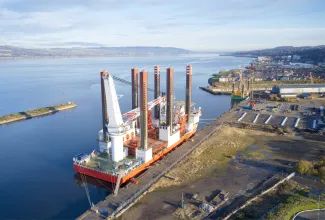
The first ScotWind leasing awards were granted by Crown Estate Scotland in 2022 - 20 offshore wind projects, with a combined 27.6GW of capacity, was a fantastic economic and environmental good-news story. A further announcement followed in March 2023 with an additional 13 projects offered exclusivity agreements in the Innovation and Targeted Oil & Gas (INTOG) leasing round.
So far, so positive – these projects, if successfully deployed, will secure Scotland’s place as a world leader in offshore wind. However, there is a growing anxiety that delivery at the expected scale and speed may be too difficult to achieve without significant government action to tackle the barriers to deployment.
One of the key barriers is port capacity. Suitable quay space at which to manufacture/assemble/despatch the components for projects is essential, and whilst there are numerous ports around the Scottish coastline, most are not geared up for such activity, requiring significant infrastructure investment. This takes time, money and coordination. Meantime, the current imbalance between supply and demand is creating a scramble to secure suitable quay space.
Whilst various initiatives are underway (the Strategic Investment Model (SIM) and the Floating Offshore Wind Manufacturing Investment Scheme (FLOWMIS) being examples) there remains a concern that we need faster, more direct action to kick-start investment and construction now. This has to happen if there is any chance of Scottish ports being ready to accommodate offshore projects looking for quayside in a few years.
The October ‘23 Scottish Government announcement of up to £500 million over 5 years to leverage private investment in ports, manufacturing and assembly work is welcome, but the devil will be in the detail as to how that is best spent for maximum effect. One thing remains clear – whilst developers are doing everything they can to accelerate project development, government must play a significant role for the offshore wind sector in Scotland to reach its full potential.